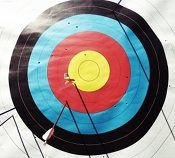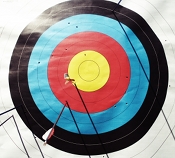My ear training classes in college were far from perfect, to say the least.
Everyone sat at their own computer/keyboard station in the piano lab. We put our ear training CD into the computer, took out the complimentary workbook, and proceeded to work out various exercises in melodic and harmonic dictation. This was all fine and dandy except the professor’s approach to teaching ear training was essentially “sink or swim.” This was beyond frustrating (except for the one person in the class that had perfect pitch) and I can remember much griping among my friends in the class.

Perhaps the worst outcome of this particular professor’s approach was the bewildering and mind-numbing effect it had, not only on me, but on the other students as well. With no set of fundamental principles or structured plan laid out by the professor as to the method of ear training, the only recourse was to assume that it was some strange and unknown property of the ear that a lucky few would somehow figure out how to use. The closest thing we got to helpful advice was the vague “You just got to keep practicing it.”
Now, as someone who has taught private lessons before, the last thing I’m going to do is tell a student to “just keep practicing it” without first breaking down the problem they’re having and giving then some systematic method of correcting it. So, my classmates and I were more or less doomed to a struggle that we neither knew the cause or the solution. Now, perhaps my experience was worse than average. In fact, I think it probably was. However, personally experiencing a horrible approach to teaching ear training has helped me to discover some basic principles that have helped me to not only make up lost ground, but to continually develop my musical ear.
The ear as an instrument
I noticed early on the similarities between ear training and learning to play an instrument. In a sense, your ears are like an instrument that you have to learn how to use, and it’s a gradual process. However, ear training isn’t taught with the same tactics in mind as is learning to play an instrument. The obvious difference being that ear training is taught in a classroom setting while learning to play an instrument is one-on-one with a professor. Now, ear training will never be taught in such a personal setting, at least not in any music school, but, whether you are a college student taking an ear training course or you’re doing it on your own, the first thing you have to do is take control of your own learning. No one else but you is responsible for what you learn.
Be your own critic
One of the most important things you have to know in ear training, just like in learning to play an instrument, is how to critique your own work. When you’re learning to play a piece of music on your instrument, you know when you made a mistake. You know when you could have played a particular passage better. You know what sections need in improvement. It’s the same with ear training. Never rely on grades to tell you how you’re doing. You know if a particular exercise is giving you trouble. You know when you haven’t fully mastered something yet. You are the judge of your own work.
Stray from the course
In conjunction with knowing how to critique your work is also knowing when to deviate from the course. Now, if you taking a college course in ear training, your options here are a little more limited. What I mean by “deviating” is to know when the prescribed course is not helping and then how to compensate for it.
I’ll give you a personal example: I was having a difficult time discerning sixths when the notes were played together but I seemed to not have a problem when the notes were played consecutively. I’m not sure why I had this problem but I did. So after struggling with this for a while and getting nowhere, I stopped and went back in the course to something I felt confident with and then worked towards the spot I was having trouble with. As it turns out, I hadn’t learned to discern melodic sixths as well as I thought I had and going through that process again solved the problem of discerning harmonic sixths. This is an example of both where I failed to critique my work adequately and I deviated from the course.
Know what you’re aiming towards
Finally, this is more of mental game I play with myself that may or may not help you: I like to look ahead in anything I’m learning. I like to see what’s coming next, both short-range and long-range. Even if I don’t understand yet what is coming next, it at least gives me a mental context in which to place what I am learning. Not only that, it’s a reminder that what I’m learning is not an end in itself, but it leads to something else.
It’s all too easy to blindly allocate time to training without giving enough thought to how you’re training. Though it can feel good to know you’ve spent the time, make sure it’s also showing the results you want! Use Joseph’s tips above to ensure your training stays effective and you get the results you need to stay motivated.
Any questions? Leave a comment!
Read Joseph’s last post “Ear Training and How We Learn” to learn about the process of training your ears – and learning in general!









